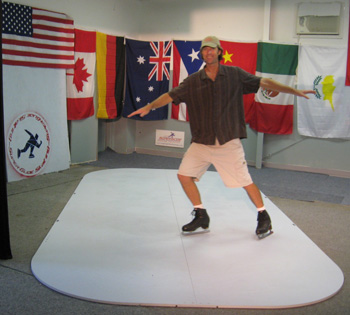March 9, 2009
Is There Such A Thing As Green Ice? Well, Maybe

By Michael D. Shaw
An interesting paper by Federico Formenti and Alberto Minetti—appearing in the January, 2008 issue of the Biological Journal of the Linnean Society—holds that humans first traveled on ice to save energy. Of course, back in that era (around 2000 BC), the energy being saved was strictly of the natural biological variety.
Their study examined the energy-saving benefits of moving along on skates fashioned from animal bones and skin, and argues that southern Finland could have been the birthplace of skating. With the advent of metal blades—perhaps by the Dutch before the 15th century—the motion was improved, but until 1850 and the all-steel configuration, a skate was little more than a wooden footplate, attached to the foot with leather straps.
The physics of ice skating are still not well understood, although some new discoveries are challenging the old notion that either pressure or friction melts the ice, creating a liquid water lubricant on the surface. For one thing, scientists have calculated that pucks and skates do not generate enough pressure to instantly liquefy ice. For another, Professor Gabor Somorjai of the Lawrence Berkeley National Laboratory has found that a “quasi-fluid” or “water-like” layer exists on the surface of ice and may be thicker or thinner depending on temperature.
That is, no melting is required. This layer is always there, even at extremely low temperatures. At -250° F (-157° C), for example, this layer is one molecule thick. As the temperature increases, the layer gets thicker, and can explain the difference between so-called fast ice and slow ice. Figure skaters skate on warmer ice than hockey players, preferring the softer landing derived from the thicker surface water layer.
History records that the first rink with artificially frozen ice, called the Glaciarium, was opened in London in 1876. Three years later, Madison Square Garden was the site of the first frozen rink in the United States. Fast forward to the present, with approximately 3,000 ice rinks in the U.S., and 5,500 in Canada.
In recent years, though, energy costs have become more of a concern in these rinks, and in certain cases, the refrigeration systems were never intended for year-round operation. One solution to this problem is synthetic ice—made of plastic and first introduced in the 1960s.
The early versions of synthetic ice required the application of silicones to the surface, and also utilized crude methods of joining together the plastic panels, which could actually trip the skaters. Not surprisingly, these early iterations left a poor impression.
Present-day synthetic ice, usually ultra-high molecular weight polyethylene or a high density polyethylene (HDPE) and sometimes sprayed with friction-reducing solution or wax, fits together like a jigsaw puzzle. Manufacturers claim the more you skate on it, the better the surface gets. It is suitable for all ice activities, and you can use normal skates. In appearance, it looks like a giant plastic cutting board.
François Bilodeau, president of Montreal-based Glace Synthetique du Canada Inc., says that once skaters get past the initial 15 percent extra effort needed to skate on the surface made of synthetic polymers, the rest is smooth skating. “The advantage of plastic is there’s no maintenance, no refrigeration needed, no chemicals or ice-cleaning machine, so the energy costs are zero,” he said. While the surface is not yet suitable for the National Hockey League, aspiring players use it for practice, citing the built-in extra effort required.
Plastics industry blogger Barry Eisenberg describes how the Japanese ice skating boom was saved from high energy costs with the new synthetic ice. Annual savings of $190,000 on refrigeration and water costs are mentioned.
From the Finns of 4000 years ago trying to save human energy by traversing natural ice, to present day people using synthetic ice to save “synthetic” energy. Quite a journey.

